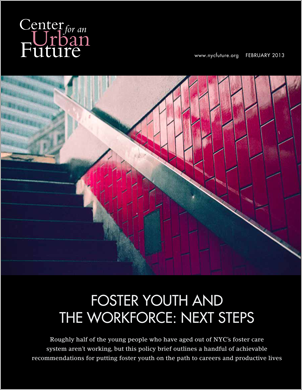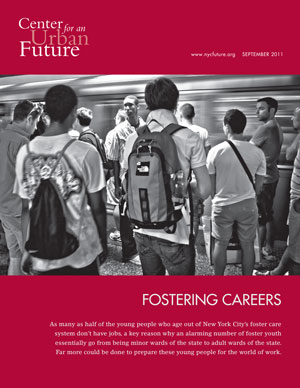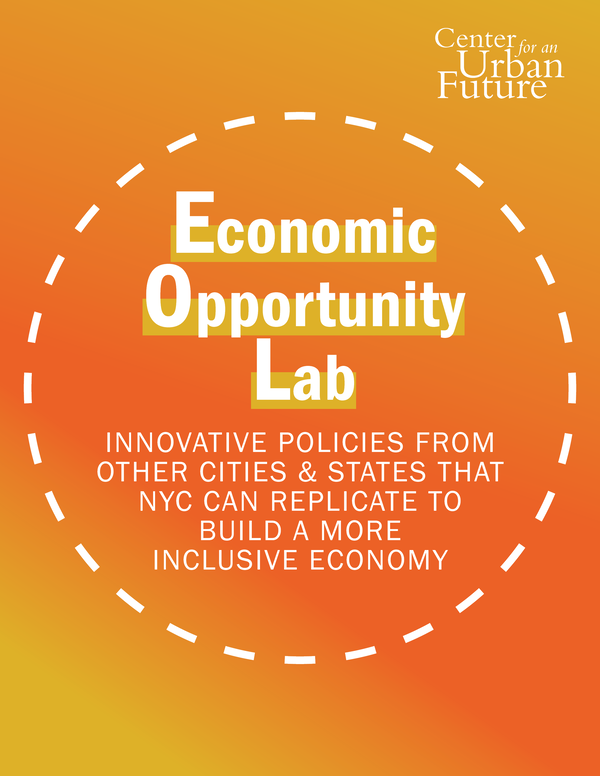Click here to download this policy brief as a PDF.
One of the most critical challenges the next mayor will need to confront is the alarming rise in the number of disconnected youth in the five boroughs. There are an estimated 130,000 young people in the city between 16 and 24 who are neither working nor in school, up by 20 percent since the 2008 recession. Unless the city can put more of these young people on the path to productive lives, they will almost certainly struggle with their transition to adulthood, and the city’s economy and budget will bear the cost of their failures.
But policymakers in the city have struggled to make progress against this ominous trend, in part because of its scale and complexity. It is hard to solve a problem that afflicts one out of every eight youth in New York City, especially given their diversity along so many dimensions.
One possible solution is to begin attacking the problem by tackling one fairly small subset of the city’s disconnected youth population: foster youth.
Only about 900 foster youth age out of the city’s foster care system each year, and caseworkers are in regular touch with foster youth until that point. After leaving care, however, foster youth pass abruptly from a highly structured adolescence to an adult life that is utterly unstructured and unsupported. After leaving care, foster youth are far more likely to flounder than other young adults, even other youth of color living in poverty.
Our recent Fostering Careers study found that roughly half of all former foster youth in their early 20s are unemployed at any given time, a key reason for their poor adult outcomes. Because so few foster youth seem to connect to the workforce at the same age as their peers, they are more likely to slide into homelessness, welfare dependence or incarceration.
Fortunately, there is a real opportunity now to make headway in the problem. The agency responsible for foster youth, the Administration for Children’s Services (ACS), has prioritized the needs of youth in care and developed at least two initiatives to improve the foster care system’s capacity to support their career aspirations. In addition, over the past year, ACS and other city agencies that have responsibility over the foster youth population—including the Department of Education, the Department of Youth and Community Development and the Department of Small Business Services—have come together in public and private forums that we convened and demonstrated a new willingness to work together in finding solutions to this problem.
In the months ahead, policymakers need to build on this momentum. In this policy brief, we lay out six achievable and low-cost recommendations that city officials could take to connect more foster youth to the workforce and increase their chances of leading productive lives.
* * *
Create a new office focused on helping foster youth transition to adulthood
ACS has recently achieved some success in improving child safety and well-being, and Commissioner Richter has brought greater emphasis on serving foster youth. Still, it remains difficult to point to specific initiatives to aid foster youth in preparing for the world of work, and other city agencies, for the most part, have yet to align their programs with the special needs of foster youth. ACS needs a stronger strategic focus, as does the city as a whole.
At one time, ACS’s Office of Youth Development represented the agency’s commitment to bring managerial focus to the needs of foster youth. When ACS disbanded the office in 2008, that focus weakened. The Office of Youth Development should be reconstituted, but not simply as a copy of the original. The office was abolished in part because of concerns about its effectiveness, and it is important not to recreate any shortcomings in that office. Instead, the city should build a new Office of Youth Development around the tasks that need to be carried out, including:
-
Designing a continuum of services and referrals to services across agency lines;
-
Developing creative interventions to support foster youth, along with outcome measurements to evaluate the effectiveness of those interventions;
-
Providing professional development in the needs of foster youth to staff outside the child welfare system;
-
Building partnerships with large employers or clusters of employers in a high-demand sector
While the previous Office of Youth Development was housed at ACS, it would make sense to locate the new unit in the office of the Deputy Mayor for Health and Human Services, with staff assigned from ACS and other relevant agencies. This would create a vehicle for interagency collaboration, rather than constructing another silo within ACS. In addition, the office need not be limited to serving foster youth, although it should serve a discrete population rather than the broader population of disconnected youth. One strategy would be for the office to focus on improving the way New York City meets the needs of both court-involved and foster youth.
* * *
Help to scale up two highly effective “bridge model” programs that provide integrated workforce and educational services to foster youth
To find New York City’s most promising breakthrough in serving high-needs foster youth, take the 2 or the 5 train to the south Bronx. Within a few blocks of one another, the Academy (operated by F.E.G.S. Health and Human Services) and the Next Generation Center (operated by the Children’s Aid Society) have pioneered a strategy to meet the complex needs of foster youth with barriers to employment. While their strategies are not identical, the two groups share a common approach: providing multiple services under one roof, including education, preparation for work, and job search, that help foster youth “bridge” the gap to the skills they will need in adulthood. In addition, foster youth can always return; no one is rejected or expelled. This bridge model was developed by a collaborative of foster care agencies, and agencies throughout the city refer clients who are not on track to make a successful transition to adulthood to the Academy or the Next Generation Center.
ACS Commissioner Ron Richter has hailed the bridge model as a promising strategy, as did former ACS Commissioner John Mattingly before him. Yet the Academy and the Next Generation Center receive no public funding, instead financing their operations by patching together grants from private funders. The return on public investment, however, could be substantial: at fairly modest cost ($5,000/client/yr), the bridge model facilities can change the trajectory of the most vulnerable youth from adult wards of the state to self-sufficient taxpayers. With modest public support, new bridge model facilities could be opened in other boroughs and carefully evaluated to document their effectiveness.
The Mayor should identify potential funding sources both within and outside of ACS to support the bridge model. Furthermore, advocates for foster youth can and should request funding from the New York State Legislature and the City Council.
* * *
Collect and publicly release data on foster youth outcomes after discharge.
ACS collects data intended to ensure that foster youth are preparing for their transition to adulthood. Yet ACS officials acknowledge that they do not collect the most important information of all: data on foster youth outcomes in adulthood. The services provided to foster youth are intended to help foster youth develop into healthy adults, and without data on foster youth experiences in adulthood, it is hard to say which strategies help foster youth and which do not.
That could change soon, thanks to a path-breaking project in Los Angeles. With funding from the Hilton Foundation, Los Angeles child welfare officials arranged for a leading youth development expert, Dennis Culhane, to follow former foster youth and youth formerly under juvenile probation supervision into adulthood by matching administrative data on the study group with administrative data on their use of services in five domains: public welfare, criminal justice, health, mental health and substance abuse treatment. In addition, he examined their employment and education outcomes well into their twenties. Culhane’s findings opened a remarkable window on the difficulties foster youth face in adulthood, especially those who fall into the juvenile justice system.
In September 2012, New York City’s Center for Innovation through Data Intelligence received a Hilton grant to replicate the Culhane study in the five boroughs. The results are likely to reveal important information about the adult lives of New York City’s foster youth. That information will provide the basis for better services and more accountability. However, providing that information on a one-time basis in a report format is not enough. Instead, annual measures of foster youth outcomes in adulthood should be added to the Mayor’s Management Report. The city and each individual agency should be held accountable for measurably improving the adult outcomes of foster youth over time.
In addition, the city should follow the lead of California, which leverages data on foster youth at the point of discharge far more effectively than New York City does. For example, California posts educational attainment of its foster youth on a quarterly basis. New York City can and should achieve the same capacity.
* * *
Establish a system of collaborative partnerships between foster youth agencies and non-profits participating in the Department of Small Business Services’ Community Partners program.
Foster care caseworkers for the most part lack extensive experience with the city’s workforce system. They have not worked directly with employers, guided foster youth through the intimidating world of Workforce1 Centers, or developed contacts among the non-profit organizations that specialize in preparing youth for jobs and careers.
The Community Partners program, an initiative of the Department of Small Business Services (SBS), could go a long way toward bridging the gap between foster care and workforce development. Under this program, the Workforce1 Centers provide information to community-based organizations on job openings, the requirements for those openings and the kind of preparation their clients need to get hired. The organizations send clients to apply for the openings. The hire rate is reportedly higher for applicants going through the Community Partners program than for applicants who begin the process at a Workforce1 Center. Currently, however, foster care agencies do not participate in the Community Partners program.
Community Partners should be an extremely valuable asset for foster youth. The stakeholders we convened discussed this program at some length. While they did not settle on a specific approach, they agreed that some form of partnership between foster care agencies, SBS and organizations participating in the Community Partners program would make sense. Also, connecting foster parents to workforce programs would strengthen their ability to assist foster youth and model productive adult behavior for them. The most effective strategy should be developed through a collaborative task force between SBS and ACS, possibly with assistance from DYCD. More broadly, the Workforce1 Centers should provide services tailored to the needs of disconnected and at-risk youth, a population that includes many foster youth. Stationing caseworkers from the Department of Youth and Community Development or the Department of Education would be worth considering.
* * *
Ensure more effective access to youth and supportive programs.
New York City has a number of programs that fall short of providing the most effective support to foster youth because they are targeted too generally and do not align with other relevant programs. The Department of Youth and Community Development (DYCD), for example, funds several programs to support youth, including its Out of School Youth Program, Young Adult Internship Program and Young Adult Literacy Programs. But the agency could enhance its focus on the very hardest cases, and foster youth would provide an excellent starting point. DYCD could expand foster youth participation in these programs by providing special outreach to foster care agencies and automatic eligibility for foster youth.
ACS oversees subsidized child care for thousands of low-income parents. Foster youth parents should receive automatic eligibility for child care, as public assistance recipients already do. Three out of four former foster youth who enter homeless shelters are parents with children. Clearly, providing those parents an opportunity to find and keep jobs would be far less expensive than maintaining them in the shelter system. Other agencies should also examine opportunities to adapt their services to the specific needs of foster youth.
* * *
Fund a public-private partnership to support foster youth internships and subsidized employment.
The Culhane study quantified the cost of former foster youth to Los Angeles County and the State of California. Over four years, former foster youth required over $12,000 in public services, and foster youth who committed crimes and entered the court system cost more than $36,000. It would be far more cost-effective and humane to support the aspirations of foster youth while they are still in care. Furthermore, other states and localities have found employers to be willing partners in assisting foster youth, such as San Francisco and Atlanta. Here in New York City, the Catholic Guardian Society and Fedcap have forged strong employer partnerships.
Major opportunities await New York City if it can build strong relationships with employers on behalf of foster youth. We propose a challenge grant initiative, in which the city matches private employers dollar for dollar to support foster youth internships and subsidized employment opportunities.
* * *
Key Findings from our Fostering Careers Study
-
Youth in foster care are a relatively small population, comprising about 7,000 teens and young adults between the ages of 14 and 21.
-
About 50 percent of former foster youth are unemployed at any given time, roughly 1,400 of the 2,800 former foster youth currently between the ages of 21 and 24.
-
Twenty-one percent of foster youth who left care in 2004 entered a homeless shelter within three years of discharge, up from 15 percent during the 1990s.
-
Only 15 percent of 8th grade teens in foster care were performing at grade level in English or Math, compared to 38 percent and 46 percent among other 8th grade youth. It seems likely that the high school dropout rate among foster youth is extremely high, although no data was available on this subject.
-
City agencies are not effectively collaborating or sharing information on foster youth they serve.
-
The city does not systematically track the outcomes of foster youth in adulthood, making it impossible to prove the effectiveness of promising approaches or reward the most successful providers.
* * *
Fostering Careers
In February 2012, the Center for an Urban Future convened a symposium on foster youth and the workforce. Ronald Richter, the newly appointed Commissioner of the city’s Administration for Children’s Services (ACS), delivered the keynote address, and top officials from the Human Resources Administration, the Center for Economic Opportunity and the Departments of Small Business Services and Youth and Community Development spoke as well. They confirmed a key recommendation of the Fostering Careers report: the need for interagency collaboration to support foster youth, so that ACS was not left on its own to assist a population of young people whose needs touch almost every city agency.
Next, we convened a stakeholder meeting of ACS and other city/state agency officials, foster youth and workforce professionals and private funders. The group compared notes on the assets and needs of individual agencies, and brainstormed potential opportunities to work together and develop more cohesive systems to assist foster youth. They explored strategies to track foster youth outcomes across systems so that effective interventions could be identified and replicated, and concluded with a broad consensus to continue the discussion over time. Since the task force’s meeting, the Center has convened a number of conference calls and individual meetings.
Since the release of Fostering Careers, some important advances have taken place. Commissioner Richter has appointed a new director of ACS’s Education Unit to build a stronger partnership with the city Department of Education, a major concern of the Fostering Careers report. ACS is preparing a new initiative, the Housing Academy Collaborative, to prepare foster youth to live on their own, and this initiative will include an employment training component. The Department of Youth and Community Development released a new RFP for the Summer Youth Employment Program that may expand the number of foster youth who participate in the Summer Youth Employment Program.




